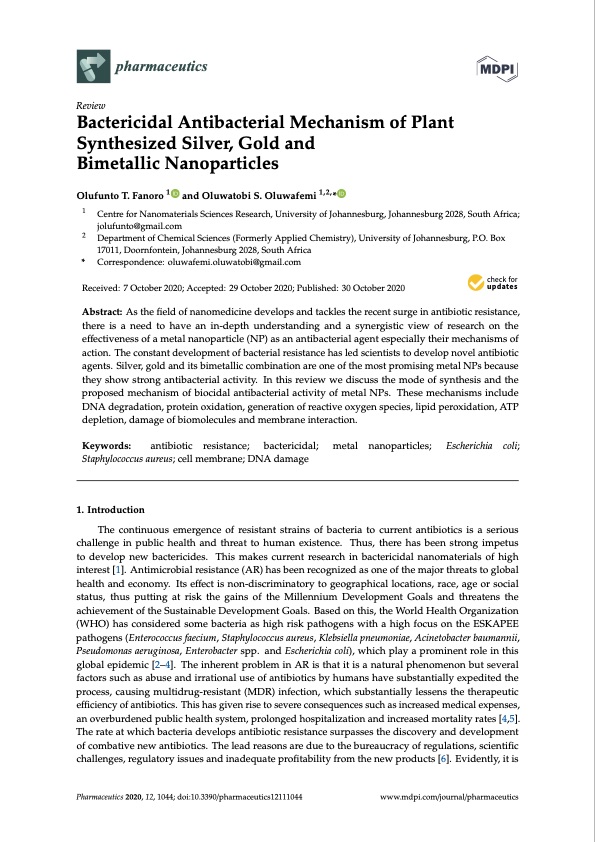
PDF Publication Title:
Text from PDF Page: 001
pharmaceutics Review Bactericidal Antibacterial Mechanism of Plant Synthesized Silver, Gold and Bimetallic Nanoparticles Olufunto T. Fanoro 1 and Oluwatobi S. Oluwafemi 1,2,* 1 Centre for Nanomaterials Sciences Research, University of Johannesburg, Johannesburg 2028, South Africa; jolufunto@gmail.com Department of Chemical Sciences (Formerly Applied Chemistry), University of Johannesburg, P.O. Box 17011, Doornfontein, Johannesburg 2028, South Africa 2 * Correspondence: oluwafemi.oluwatobi@gmail.com Received: 7 October 2020; Accepted: 29 October 2020; Published: 30 October 2020 Abstract: As the field of nanomedicine develops and tackles the recent surge in antibiotic resistance, there is a need to have an in-depth understanding and a synergistic view of research on the effectiveness of a metal nanoparticle (NP) as an antibacterial agent especially their mechanisms of action. The constant development of bacterial resistance has led scientists to develop novel antibiotic agents. Silver, gold and its bimetallic combination are one of the most promising metal NPs because they show strong antibacterial activity. In this review we discuss the mode of synthesis and the proposed mechanism of biocidal antibacterial activity of metal NPs. These mechanisms include DNA degradation, protein oxidation, generation of reactive oxygen species, lipid peroxidation, ATP depletion, damage of biomolecules and membrane interaction. Keywords: antibiotic resistance; bactericidal; metal nanoparticles; Escherichia coli; Staphylococcus aureus; cell membrane; DNA damage 1. Introduction The continuous emergence of resistant strains of bacteria to current antibiotics is a serious challenge in public health and threat to human existence. Thus, there has been strong impetus to develop new bactericides. This makes current research in bactericidal nanomaterials of high interest [1]. Antimicrobial resistance (AR) has been recognized as one of the major threats to global health and economy. Its effect is non-discriminatory to geographical locations, race, age or social status, thus putting at risk the gains of the Millennium Development Goals and threatens the achievement of the Sustainable Development Goals. Based on this, the World Health Organization (WHO) has considered some bacteria as high risk pathogens with a high focus on the ESKAPEE pathogens (Enterococcus faecium, Staphylococcus aureus, Klebsiella pneumoniae, Acinetobacter baumannii, Pseudomonas aeruginosa, Enterobacter spp. and Escherichia coli), which play a prominent role in this global epidemic [2–4]. The inherent problem in AR is that it is a natural phenomenon but several factors such as abuse and irrational use of antibiotics by humans have substantially expedited the process, causing multidrug-resistant (MDR) infection, which substantially lessens the therapeutic efficiency of antibiotics. This has given rise to severe consequences such as increased medical expenses, an overburdened public health system, prolonged hospitalization and increased mortality rates [4,5]. The rate at which bacteria develops antibiotic resistance surpasses the discovery and development of combative new antibiotics. The lead reasons are due to the bureaucracy of regulations, scientific challenges, regulatory issues and inadequate profitability from the new products [6]. Evidently, it is Pharmaceutics 2020, 12, 1044; doi:10.3390/pharmaceutics12111044 www.mdpi.com/journal/pharmaceuticsPDF Image | Bactericidal Antibacterial Mechanism of Plant Nanoparticles

PDF Search Title:
Bactericidal Antibacterial Mechanism of Plant NanoparticlesOriginal File Name Searched:
pharmaceutics-12-01044-v2.pdfDIY PDF Search: Google It | Yahoo | Bing
Turbine and System Plans CAD CAM: Special for this month, any plans are $10,000 for complete Cad/Cam blueprints. License is for one build. Try before you buy a production license. More Info
Waste Heat Power Technology: Organic Rankine Cycle uses waste heat to make electricity, shaft horsepower and cooling. More Info
All Turbine and System Products: Infinity Turbine ORD systems, turbine generator sets, build plans and more to use your waste heat from 30C to 100C. More Info
CO2 Phase Change Demonstrator: CO2 goes supercritical at 30 C. This is a experimental platform which you can use to demonstrate phase change with low heat. Includes integration area for small CO2 turbine, static generator, and more. This can also be used for a GTL Gas to Liquids experimental platform. More Info
Introducing the Infinity Turbine Products Infinity Turbine develops and builds systems for making power from waste heat. It also is working on innovative strategies for storing, making, and deploying energy. More Info
Need Strategy? Use our Consulting and analyst services Infinity Turbine LLC is pleased to announce its consulting and analyst services. We have worked in the renewable energy industry as a researcher, developing sales and markets, along with may inventions and innovations. More Info
Made in USA with Global Energy Millennial Web Engine These pages were made with the Global Energy Web PDF Engine using Filemaker (Claris) software.
Infinity Turbine Developing Spinning Disc Reactor SDR or Spinning Disc Reactors reduce processing time for liquid production of Silver Nanoparticles.
| CONTACT TEL: 608-238-6001 Email: greg@infinityturbine.com | RSS | AMP |